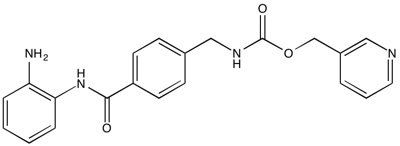MS-275 (Entinostat) | HDAC inhibitor
NMR (Conforms)

Available Options
| Size | Price | Quantity | |
|---|---|---|---|
| 5 mg | $50.00 | ||
| 25 mg | $160.00 |
MS-275 (Entinostat 209783-80-2) is a potent HDAC inhibitor. Selective for HDAC1 (IC50 = 300 nM) over HDAC3 (IC50 = 8 μM) and HDAC8 (IC50 100 μM).1 In vivo, MS-275, has been shown to inhibit tumor growth via induction of the tumor suppressors p21WAF1/CIP1 and gelsolin2 and to block cell proliferation in a variety of cancer cell lines. MS-275 has also shown significant anti-rheumatic activity in rat and mouse arthritis models.5
References/Citations:
1) Hu et al. (2003), Identification of novel isoform-selective inhibitors within class 1 histone deacetylases; J. Pharmacol. Exp. Ther., 307 720
2) Saito et al. (1999), A synthetic inhibitor of histone deacetylase, MS-275, with marked in vivo antitumor activity against human tumors; Proc. Natl. Acad. Sci. USA, 96 4592
3) Eyupoglu et al. (2006), Experimental therapy of malignant gliomas using the inhibitor of histone deacetylase MS-275; Mol. Cancer Ther., 5 1248
4) Lee et al. (2001), MS-275, a histone deacetylase inhibitor, selectively induces transforming growth factor beta type II receptor expression in human breast cancer cells; J. Pharmacol. Exp. Ther., 307 720
5) Lin et al. (2007), Anti-rheumatic activities of histone deacetylase (HDAC) inhibitors in vivo in collagen-induced arthritis in rodents; Br. J. Pharmacol., 150 862
6) Fukuchi et al. (2015), Class I histone deacetylase-mediated repression of the proximal promoter of the Activity-regulated Cytoskeleton-associated Protein Gene regulates its response to brain-derived neurotrophic factor; J. Biol. Chem. 290 6825 [Focus Biomolecules Citation]
NMR (Conforms)
Safety Data Sheet:
Product Data Sheet:
Materials provided by Focus Biomolecules are for laboratory research use only and are not intended for human or veterinary applications. Please note that we do not sell to individuals and that all orders placed by non-research organizations will incur a $20 restocking/refund fee
MS-275 (Entinostat 209783-80-2) is a potent HDAC inhibitor. Selective for HDAC1 (IC50 = 300 nM) over HDAC3 (IC50 = 8 μM) and HDAC8 (IC50 100 μM).1 In vivo, MS-275, has been shown to inhibit tumor growth via induction of the tumor suppressors p21WAF1/CIP1 and gelsolin2 and to block cell proliferation in a variety of cancer cell lines. MS-275 has also shown significant anti-rheumatic activity in rat and mouse arthritis models.5
References/Citations:
1) Hu et al. (2003), Identification of novel isoform-selective inhibitors within class 1 histone deacetylases; J. Pharmacol. Exp. Ther., 307 720
2) Saito et al. (1999), A synthetic inhibitor of histone deacetylase, MS-275, with marked in vivo antitumor activity against human tumors; Proc. Natl. Acad. Sci. USA, 96 4592
3) Eyupoglu et al. (2006), Experimental therapy of malignant gliomas using the inhibitor of histone deacetylase MS-275; Mol. Cancer Ther., 5 1248
4) Lee et al. (2001), MS-275, a histone deacetylase inhibitor, selectively induces transforming growth factor beta type II receptor expression in human breast cancer cells; J. Pharmacol. Exp. Ther., 307 720
5) Lin et al. (2007), Anti-rheumatic activities of histone deacetylase (HDAC) inhibitors in vivo in collagen-induced arthritis in rodents; Br. J. Pharmacol., 150 862
6) Fukuchi et al. (2015), Class I histone deacetylase-mediated repression of the proximal promoter of the Activity-regulated Cytoskeleton-associated Protein Gene regulates its response to brain-derived neurotrophic factor; J. Biol. Chem. 290 6825 [Focus Biomolecules Citation]
Related HDAC Inhibitors
Download
Calculate the molar concentration, mass or volume in a solution.
Concentration × Volume × Molecular Weight = Mass
Focus Biomolecules • Plymouth Meeting, PA USA • 1-855-FOCUS21
Focus Biomolecules
Plymouth Meeting, PA USA
1-855-FOCUS21
Website Created by Advanta Advertising LLC.

